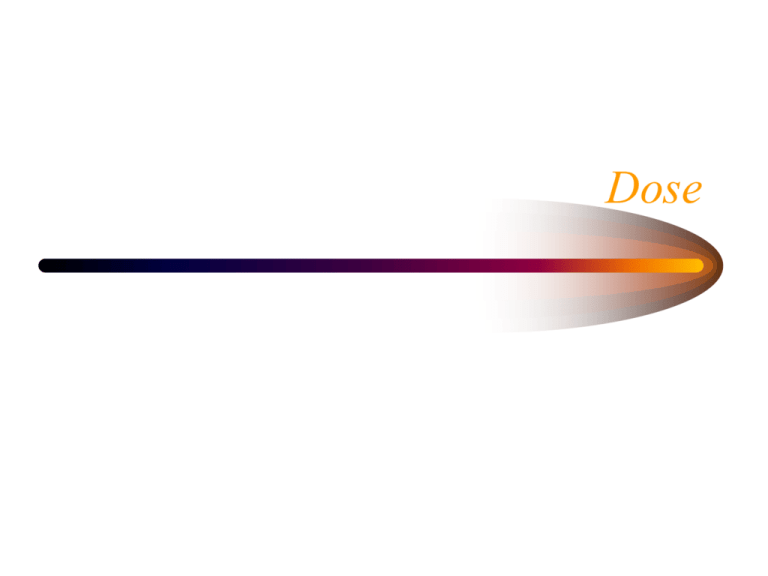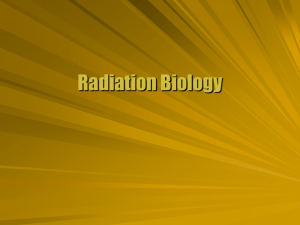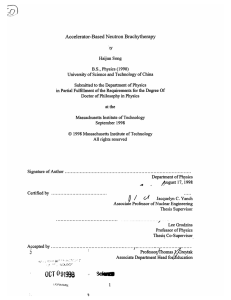Dose
advertisement

Dose Energy Gained • Particles lose energy in matter. • Eventually energy loss is due to ionization. • An important measure is the amount of energy gained by the material as a particle passes or stops. Energy Transferred • Energy transferred describes the kinetic energy gained by charged particles. • Energy imparted is the energy lost by charged particles. particle energy 10 MeV 5.4 3.6 energy transferred 9.0 energy imparted 2.8 4.2 2.0 3.3 2.8 1.1 0.1 2.8 1.1 Energy Imparted • Energy transferred – Radiant energy into a volume from uncharged particles – Radiant energy out tpo uncharged particles (not brem or annihilation) – Energy change from mass nonrad Etr ( Rin )unc ( Rout )unc Q • Energy imparted – Start with energy transferred – Energy in from charged particles – Energy out from charged particles nonrad E ( Rin )unc ( Rout )unc ( Rin ) chg ( Rout ) chg Q Kerma • Kerma is the energy transferred per unit mass. – Kinetic Energy Released per unit MAss dEtr K dm • Radiative kerma is the energy loss per mass due to brem and annihilation. rad dRunc Kr dm • Collision kerma subtracts the reradiated photons. – Net energy transferred per mass dEtrnet KC K K r dm Absorbed Dose • Absorbed dose or dose is the energy imparted per unit mass. • Like kerma dose is based on mean changes in energy. • Two units are used. – 1 gray (Gy) = 1 J / kg – 1 rad = 100 erg / g (older) dE D dm J 107 erg 1 Gy kg 103 g erg 10 4 100 rad g Lethality • Lethality refers to the likelihood that a dose will be fatal. – Cell death – Whole body death (see graph at right) Lethality % • Dose can be compared to physical effects. Dose (cGy) Federation of American Scientists Equilibrium • Measuring the relationship between energy transferred and imparted requires equilibrium conditions. • Radiation equilibrium ( Rin )chg ( Rout )chg ( Rin )unc ( Rout ) unc E Q • Charged particle equilibrium – Looser requirement E ( Rin )unc ( Rout )unc Q Exposure • Exposure is defined by the ionization produced by photons. – Gammas and X-rays – Charge per unit mass in air • The original unit is 1 esu / cm3 of dry air at STP (1928). – Roentgen (R) – R = 2.58 x 10-4 C / kg (1962) Useful Conversion • Show that the original roentgen is equivalent to the modern one. • Look up constants: – Density of air at STP is 0.001293 g / cm-3 – 1 esu = 3.34 x 10-10 C • 3.34 x 10-10 C / 1.293 x 10-6 kg = 2.58 x 10-4 C / kg Gamma Rate • Assume a point source of gammas. – Activity C – Average photon energy E • Consider a sphere or radius r. – Fluence through sphere F – Mass energy absorption men/r = 2.7 x 10-3 m2/kg • Find the dose and exposure rate. – 1 R = 0.0088 Gy • Rate of energy release: dE CE dt CE • Fluence rate: F 4r 2 • Dose rate: men CE men D F r 4r 2 r 1.27 10 6 (m 2s/BqJ) CE Gy/s 2 r • Exposure rate: 2 0 . 5 (m s/BqJ) CE X R/h 2 r Radiation Factor • The effect of radiation on tissue depends on the LET as well as the dose. – Higher LET is more damaging. • Radiation has a weighting factor based on particle. – Factor WR or Q – Updated in 1991 • In terms of LET – LET L (keV / mm in water) – < 10; WR = 1 – 10 – 100; WR = 0.32L – 2.2 – > 100; WR 300 / L • In terms of particle – e, g, m; WR = 1 – n; WR = 5 – 20 – p; WR = 5 – a; WR = 20 Restricted Stopping Power • Secondary electrons ejected from atoms are delta rays. – Deltas deliver most of the dose – Energy less effective if it’s too high • Restricted stopping power measures the energy lost up to a limit D. D dE m QP (Q)dQ Qmin dx Typical Problem • Estimate a cutoff value for irradiating 300 Å viruses. Answer • Most energetic delta range should not exceed 300 Å. – Find range limit 3 x 10-6 cm • Range in water – 500 eV is 2 x 10-6 g/cm2 – 1 keV is 5 x 10-6 g/cm2 • Estimate cutoff at 700 eV. Equivalent Dose • The equivalent dose is a measure that combines the type of radiation and dose. HT WR D • Unit is Sievert (Sv) – 1 Gy equivalent • Older unit is rem – Roentgen equivalent man – 1 rad equivalent – 100 rem = 1 Sv • Natural doses – Cosmics: 0.3 mSv / yr – Soil: 0.2 mSv / yr – Radon: 2 mSv / yr – Total natural: 3 mSv / yr • Environmental hazards – Flying at 12 km: 7 mSv / hr – Chest x-ray: 0.1 mSv – Mammogram: 1 mSv – CT scan: 20 mSv Neutron Interactions • Neutrons present a unique situation for dose determination. – No interaction with atomic electrons – Cross sections vary with target nucleus Neutron Scattering • Elastic scattering from nuclei is the most important process for neutron energy loss. – Assume classical collision – Set M = 1 and compare for nuclei Qmax 12 MV 2 12 MV f2 4mM 2 1 ( MV ) 2 2 ( M m) 4mMEn ( M m) 2 • Nucleus – 1H – 2H – 4He – 9Be – 12C – 16O – 56Fe – 118Sn – 238U Qmax/En 1.000 0.889 0.640 0.360 0.284 0.221 0.069 0.033 0.017 Neutron Dose Equivalent • Neutron weighting factors were variable. – WR = 5-20. • The factors can be determined from assumed elastic scattering. Example • Find WR for 2-MeV neutrons. – Average recoil p is 1 MeV – Stopping power for 1 MeV p in water is 270 MeV/cm – Equal to 27 keV/mm WR 0.32L 2.2 WR 0.32(27) 2.2 6.4 Neutron Threshold • Inelastic collisions result in a nuclear reaction. – Many are endothermic – Requires extra energy • Change in rest energy • For example 32S(n,p)32P: – Eth = 0.957 MeV – 32P 32S + b– Ebmax = 1.71 MeV – T = 14.3 days – Used to detect exposure E1 E3 E4 Q Q M1 M 2 M 3 M 4 • Conservation of energy and momentum p1 p3 p4 M3 M4 E1 Eth Q M 3 M 4 M1 Neutron Activation • Time dependence of activity from neutron capture is based on exposure and decay. – Constant rate of fluence F – Minimal loss of target NT dN FN T N dt N N F T 1 e t Typical Problem • A 3-g sample of 32S is irradiated with fast neutrons at 155 cm-2s1. The cross section is 0.200 barn. What is the maximum activity? Answer • The number of target nuclei, 3 NT N A 5.64 10 22 32 • The maximum is for large t. N 1.75 Bq N max F T






